iStudy for Success!
Online learning tutorials for essential college skills.
Concept Maps
iStudy would like to acknowledge Kathryn Maxwell for revising the content of this tutorial.
Purpose
Concept mapping is a visualization tool co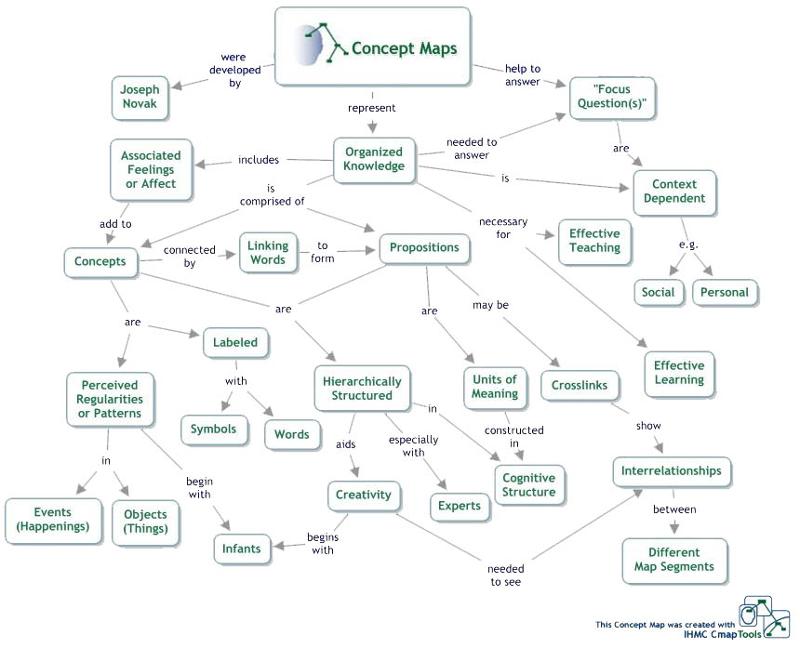 mprized of learning techniques that help develop and organize ideas. These visual and active thinking techniques can be used to create an external representation (or picture) of a set of ideas or a body of knowledge. By generating representations, tools such as concept maps, graphic organizers, webbing, idea maps, and other visual diagrams help to structure thoughts, illustrate in-depth ideas, and show relationships between and among them.
mprized of learning techniques that help develop and organize ideas. These visual and active thinking techniques can be used to create an external representation (or picture) of a set of ideas or a body of knowledge. By generating representations, tools such as concept maps, graphic organizers, webbing, idea maps, and other visual diagrams help to structure thoughts, illustrate in-depth ideas, and show relationships between and among them.
Goals and Objectives
Upon completion of this tutorial, you will be able to:
- Describe what a concept map is and describe its uses and applications
- Define and apply a variety of basic terms and ideas related to concept maps
- Create concept maps for your own use
Activities
Constructing, interpreting, and critiquing concept maps are all ways to learn about them, learn how to use them, and also why to use them. First, read the materials on concept maps. As you read through the information about concept maps, complete the activities to practice making and reading them.
- Information about Concept Maps
- Activity 1: What is a Concept Map?
- Why Use Concept Maps
- Activity 2: Benefits of Using Concept Maps
- How to Develop a Concept Map
- Principles about Linking
- Activity 3: Creating a Concept Map
- Assessment Criteria
- Activity 4: Evaluating a Concept Map
Note: All external links in this tutorial will open in a new window or tab.
References
Summary
Instructor's Guide
Information about Concept Maps
Defining Concept Maps
Concept mapping is a technique for representing what you know about a given topic. It is a process of creating a "visual map" or "web" of your knowledge. Creating a concept map is a good way for you to identify key concepts in lectures and readings. It also allows you to show how different pieces of information relate to one another.
Components of a Concept Map
Concept maps are visual representations of what we know about a topic and consist of nodes and labeled links. Concepts are sets of specific objects, symbols, or events that share common characteristics. The meaning of a concept is determined by a list of its properties, which are, in turn, other concepts. Most concepts do not exist in isolation, but rather as part of a set of related concepts.
Nodes correspond to the concepts or important terms related to your studies of a topic. For example, the concept "water" can be defined by other concepts, such as liquid, solid, and gas. The relationship of each concept to other concepts determines its meaning. Thus, a concept map is a set of relationships among other concepts.
Labeled links identify the type of relationship. Therefore, the line between a pair of concepts denotes a relationship, and the label on the line tells how the two concepts are related. For example, in a concept map of seasons, the relationship between the amount of sunlight and temperature variations is labeled as "cause" – in other words it is an action relationship between antecedent and consequent. In a concept map of dairy policies, the relationship between "dairy policy" and "federal milk marketing order" is labeled as "includes" because it represents an inclusion relationship between superset and subset.
Activity 1: What is a Concept Map?
Check to see what you have learned so far by completing the quiz below.

Why Use Concept Maps?
Student Dialog - "Why do I use concept maps?"
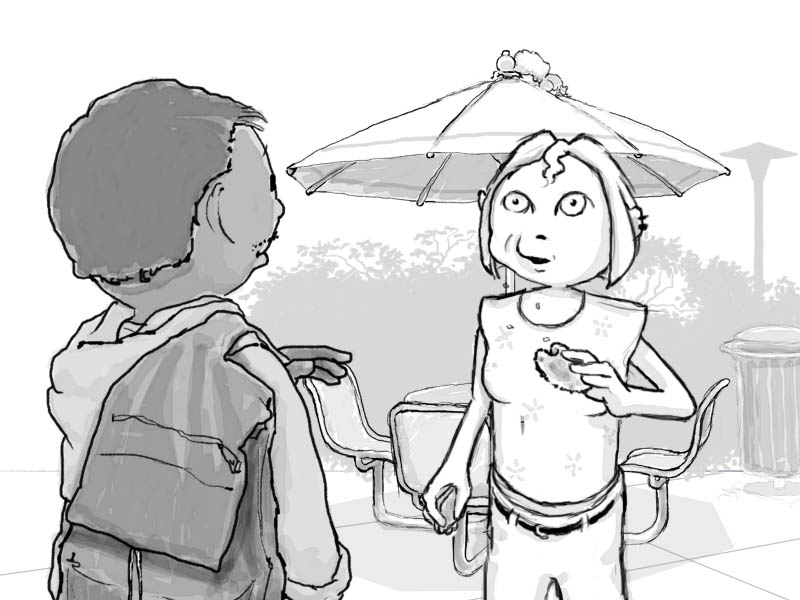 Sage: Jose, after our sessions, why do you run off to your room to create concept maps of them? And why use concept maps, anyway?
Sage: Jose, after our sessions, why do you run off to your room to create concept maps of them? And why use concept maps, anyway?
Jose: Well, they help me to visualize what I already know about a topic. They guide my study and research about that topic and can enhance meaningful learning. Not to mention that they aid me in achieving deeper learning.
Sage: Ha ha. Did you get that directly from a book?
Jose: Yep. Now, to construct a concept map, you need to determine important concepts and the relationships between these concepts. By doing that, you explore your understanding of the topic. In other words, you examine and reflect on what you know about the topic.
Sage: I think that might be useful.
Jose: I'm glad you see things my way, Sage. This way you'll be able to see the most important areas of the topic. Then you can focus on relevant information and stay organized while you study or research more information about the topic. And concept maps are adaptable. As you learn, you can adjust your map to include new concepts and ideas.
Sage: So, in order to do this, you have to analyze the patterns and structures of the topics? And that will help you to recall the information as well as help in applying the knowledge?
Jose: Yep again! See, there are benefits to this stuff.
Sage: Thanks, Jose. I promise to give it a try next time I do a research project.
Explanation
Meaningful learning requires you to relate new knowledge to existing concepts and ideas. When you learn a new concept, you add it to the appropriate place in the concept map. By interrelating concepts in networks of concepts and labeling relationships between the concepts, the concept map helps you integrate different concepts together. In order to do that, you have to analyze the patterns and structures of your topic. This promotes better memorization and recall as well as the ability to apply knowledge in new situations.
Activity 2: Benefits of Using Concept Maps
Check to see if you understand the benefits of using concept maps by completing the short quiz below.

How to Develop a Concept Map
Remember, a concept map is a visual representation of what you know about a topic. It helps you to organize, analyze, and communicate your studies and research.
Now that you know what a concept map is and all of its components, let's see how you would create one for yourself.
Steps in Developing a Concept Map
The process of concept mapping involves three major steps:
- Step 1: List key concepts/terms related to the topic
- Step 2: Build up concepts to elaborate key concepts
- Step 3: Identify links between concepts
Step 1: List key concepts related to the topic
List all the concepts related to the topic which you consider essential to understanding the topic. For example, for the topic "cooperative learning," Jose determined the key concepts to be:
- Team Responsibilities
- Individual Responsibilities
- Characteristics
- Roles
- Basic Elements
- Expected Behaviors
Step 2: Build up concepts to elaborate key concepts
After defining the key concepts, you then expand on those concepts. Ask yourself the question:
"What are the important concepts, facts, ideas, terms, etc. that explain the key concept?"
Step 3: Identify links between concepts
It is important to show how or why certain concepts relate to one another. This is called linking – explaining the connection between two separate parts of your concept map.
Making a Concept Map
Concept maps (also known as mind maps) can be made with a pencil and paper,
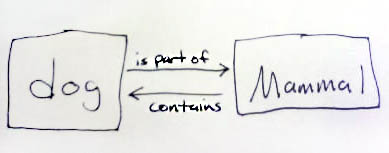
with post-it notes on a white board (you draw the links) which is great for group brainstorming because you can move the post-it notes around,
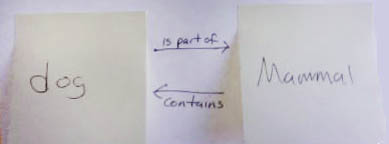
or with special computer software. Some of the more popular software includes:
- CMap (online editor)
- Buzan's iMindMap
- Microsoft Visio
A comprehensive list of concept mapping tools is located at https://en.wikipedia.org/wiki/List_of_concept-_and_mind-mapping_software and also at http://www.peterrussell.com/MindMaps/MMSoft.php .
Principles about Linking
Interlink Existing Concepts as Much as Possible
It is important that your link labels fully describe the relationship between the two concepts. This means making the labels more than simply "relates to" or "is connected to." Labels should indicate the exact nature of the relationship. Links may connect to, or be related to, more than one concept – be sure to link all related concepts together.
Why is Linking Important?
By establishing links between concepts you are able to see the "big picture" and gain a deeper understanding of a topic. In fact, your goal is to attempt to link every concept in your concept map to every other one. Trying to establish links helps you focus on which concepts are most important in order to understand a topic and identify areas within a map that you might need to work on a little more. For example, you may need to expand a map by establishing sub-concepts, or you may even need to eliminate concepts that turn out to be unimportant for a particular topic.
Most Common Words Used in Link Labels
|
Link Type
|
Example
|
|
Inclusion Links
|
- Subset of: is included in, is contained in, is example of, is part of
- Superset of: include, contain, consist of, has example, has part of
|
|
Characteristics Links
|
- has characteristic/is characteristic of
- has attribute/is attribute of
- has type/is type of
|
|
Actions Links
|
- Function: cause/is caused by
- Operation: act on/is acted on by
- generate/is generated by
- regulate/is regulated by
- determine/is determined by
- increase/is increased by
|
|
Process Links
|
- has process/is process in
- has input/is input to
- has output/is output of
|
|
Temporal Links
|
- precede
- follow
- has step/is step in
|
|
Similarity Links
|
- is similar to
- is like
- is opposite to
|
Activity 3: Creating a Concept Map
|
Now that you have a basic understanding of what a concept map is, develop a concept map on "A Dog" with pencil and paper. The following concept map is an example:
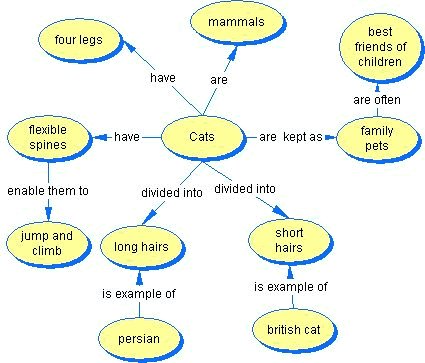
One way to begin is to list sub-topics and then classify them by ranking them from general to specific in a kind of top-down approach. For example, the topic of cats (see the concept map example above) might trigger some thoughts about mammals, different kinds of cats, or pets. These general sub-topics will most likely elicit thoughts about even more specific topics such as four legs, tails, spine, hair type, and friends of people.
Another way to begin is to simply start brainstorming or "free associating" by jotting down every idea that comes to mind. After brainstorming, you can classify the items. Make use of the tools that are available to you and that make sense for you. Consider using colors, numbers, codes, arrows, paper clips, or different sizes or colors of "sticky" or "post-it" notes.
Regardless of how you decide to approach this map, always keep in mind the central word, concept, question, or problem for which you are building the map. Then, think about the concepts, words, descriptions, subjects, items, or issues that are connected to or associated with your central word or idea.
|
Assessment Criteria
Why should you self assess your concept maps? For the same reason you assess your writings - to improve them and ensure you have accurately captured knowledge. Jonassen (1996) provides examples of how concept maps can be used to assess learning. Use the following information to assess your concept maps. However, keep in mind that there is no "right" concept map. Each student, or group of students, will likely build a different map, based upon their personal experiences. It is also important to understand that assessment of a concept map must be consistent with the needs of the content domain (Jonassen, et al., 1997).
- Assess the change in your map at various stages of a course.
Concept maps can be a dramatic way to view how your knowledge changes as a result of instruction. Concept maps that you create at the beginning and end of the course provide evidence of your growth in knowledge.
- Compare your concept map to the concept map of an expert.
Your concept map can also be compared to the concept map of an expert, most likely the course instructor. Before selecting this model, however, it is important to understand that one of the major advantages of concept maps is that they allow learners to represent knowledge through their personal experiences. So a novice's model will be very different from an expert's model. Thus, this assessment technique somewhat compromises an important advantage of concept maps.
- Compare your map to the goals of the course.
A third model is to compare your concept map to the course goals. Reviewing individual concept maps will provide evidence of how much the individual learner progressed toward these goals.
Checklist for Concept Maps
An additional tool you may want to use to evaluate your concept maps is a checklist. A downloadable RTF of this checklist is included in the left sidebar of this page.
Concept Map Evaluation Checklist
|
Criteria
|
Criteria Met?
|
|
Concepts
|
|
|
All major concepts that are relevant to the main topic have been included and represented as such.
|
|
|
Main concepts are easily identified, either by use of a larger font, a graphic or other means of emphasis.
|
|
|
All the important sub-concepts have been included and represented as such.
|
|
|
All concepts are presented with a minimum of text.
|
|
|
Concepts are well organized in a logical manner.
|
|
|
|
|
|
Links
|
|
|
All the relevant concepts are linked logically.
|
|
|
Labels accurately and concisely describe the relationship between concepts.
|
|
|
Concepts are physically arranged so links are established in the most economical way possible, without cluttering the map.
|
|
|
|
|
|
Mechanics
|
|
|
Correct spelling and grammar are used throughout the map.
|
|
|
|
|
|
Design
|
|
|
Text is clear and easy to read; font is neither too small nor too large.
|
|
|
Amount of text is appropriate for the intended audience.
|
|
|
Color is effectively used for emphasis and increased comprehension.
|
|
|
Graphics are used only when necessary to increase comprehension.
|
|
|
|
|
|
Overall
|
|
|
The concept map is clear, legible, and focused.
|
|
|
Concepts reflect the essential information about the topic.
|
|
|
Information is clear, accurate, and well organized.
|
|
|
Content is logically arranged to facilitate comprehension.
|
|
|
The concept map shows evidence of what was learned about the topic.
|
|
Activity 4: Evaluating a Concept Map
|
Compare your concept map about dogs with the concept map example provided below.
- Does the example map include nodes and concepts that you did not include?
- Did you include concepts, nodes, or linkages that may not be appropriate?
- Would you have used different key words or phrases to describe concepts?
Concept Map Example on Dogs
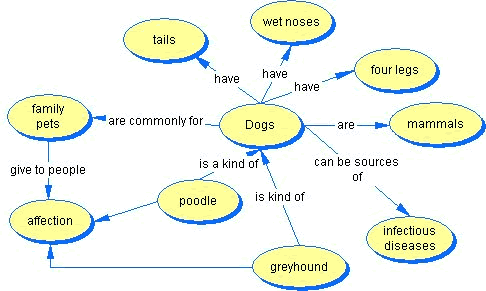
Based on your findings from this activity, critique your own concept map and reconstruct it. Refer to the check list mentioned in the previous page.
|
References
Content
Because concept maps are an external visualization of a person's ideas and body of knowledge, or how the person conceptualizes a topic, they are an excellent tool for assessing the level of a learner's knowledge on a given topic.
J. D. Novak is considered by many to be the 'father' of concept mapping. Any in-depth examination of concept mapping should include his writings.
For more information on concept mapping, please refer to:
- Jonassen, D. H., Beissner, K., & Yacci, M. (1993). Structural knowledge: Techniques for representing, conveying, and acquiring structural knowledge. Hillsdale, NJ: Lawrence Erlbaum Associates.
- Jonassen, D. H. (1996). Computers in the classroom: Mindtools for critical thinking. Engelwood Cliffs, NJ: Prentice Hall.
- Manktelow, J. (1995). Mind Tools: Improving Note Taking with Concept Maps. Retrieved March 19, 2004, from http://www.psywww.com/mtsite/mindmaps.html *
- Novak, J. D. (1998). Learning, creating, and using knowledge: Concept maps as facilitative tools in schools and corporation. Mahwah, NJ: Lawrence Erlbaum Associates.
- Novak, J. D., & Canas, A. J. The Theory Underlying Concept Maps and How to Construct and Use Them. Retrieved February 25, 2012, from http://cmap.ihmc.us/Publications/ResearchPapers/TheoryCmaps/TheoryUnderlyingConceptMaps.htm
- Shaverlson, R. J. Methods for examining representations of subject matter structure in student's memory. Journal of Research in Science Teaching, 11, (13), 231-249.
- The Center for Science Education, the University of South Carolina, Columbia. (1998). Geology 103, Water-Life Sustaining Resources, Concept Map, Retrieved March 15, 2004, from http://cse.cosm.sc.edu/env_sci/Resources/L_Sus_Res/Water/Water_Frame.htm *
- The Center for Science Education, the University of South Carolina, Columbia. (1998). Geology 103, Alternative Sources of Energy, Concept Map, Retrieved March 15, 2004, from http://cse.cosm.sc.edu/env_sci/Resources/O_Nat_Res/Alt_Energy/Alt_Eng_Frame.htm *
- Zeilik, M. Field-tested learning assessment guide. (2012). Classroom assessment techniques: Concept Mapping, Retrieved February 25, 2012, from http://www.flaguide.org/cat/conmap/conmap7.php
* Indicates that the original Website is no longer available.
Summary
Concept maps are visual representations of how concepts on a particular topic relate to each other. Nodes and links are the symbols used to create a concept map.
A concept map has to contain all of the important concepts for the topic, and it has to make sense to you. You could ask a friend who is working on the same topic to look at it to see if you missed anything, or you could ask your instructor to look at your map. You could also use a checklist to assess your map yourself.

Instructor's Guide
Quizzes, Reflective Questions, and Activities
The following assignments are embedded in the Concept Maps tutorial:
- Activity 1: Quiz - What is a Concept Map?
- Activity 2: Quiz - Benefits of Using Concept Maps
- Activity 3: Creating a Concept Map
- Activity 4: Evaluating a Concept Map
Relationship to Other iStudy Tutorials
This tutorial should be used after any tutorials on problem identification and data collection because you must have a conceptual base (built by data collection) from which to build a concept map.
Suggested In-class Methods of Presentation
Lecture
- Explain the purpose/intent of the tutorial.
- Explain general information about concept maps, and why concept maps are important.
Discussion
- Reinforce the basic concept map material as listed in the Key Points section later in this document.
- Provide examples of how concept maps can be used in topics that are relevant to the students.
Optional
- Have students work in small groups to interpret a concept map on a local or current event topic.
- Have students work in small groups to construct a simple concept map on a local or current event topic.
Note : This is an excellent opportunity to utilize and reinforce the cooperative learning techniques found in the iStudy Cooperative Learning tutorial.
Key Points
These points are covered in the iStudy tutorial, but should be emphasized in any discussions.
- What is concept mapping?
- What are the components of concept maps?
- Show examples.
- Steps in developing a concept map.
Assessment Criteria
Jonassen (1996) provides examples of how concept maps in general can be used to assess learning. If the students create a concept map for your assessment, use the following information to assess the concept maps. However, it is important to keep in mind that there is no "right" concept map. Each student, or group of students, will likely build a different map, based upon their personal experiences. It is also important to understand that assessment of a concept map must be consistent with the needs of the content domain (Jonassen, et.al, 1997).
- Assess the change in the student's map at various stages of the course.
Concept maps can be a dramatic way to view how a student's knowledge changes as a result of instruction. Concept maps that the student creates at the beginning and end of the course provide evidence of changes to the student's knowledge structure. Concept maps created at regular intervals during a course can be used to monitor student progress.
- Compare the student's concept map to the concept map of an expert.
The student's concept map can also be compared to the concept map of an expert, most likely the course instructor. This model allows the instructor the opportunity to assess if the student's knowledge structure is becoming more similar to his or her own. Before selecting this model, however, it is important to understand that one of the major advantages of concept maps is that they allow students to represent knowledge through their personal experiences. This model, therefore, somewhat compromises an important advantage of concept maps.
- Compare the student's map to the goals of the course.
A third model is to compare the student's concept map to the goals of the course. Reviewing individual concept maps will provide evidence of how much the individual student progressed toward these goals. Closer examination of the concept maps drawn by the entire class concept maps may point to opportunities of how to improve the course.
You may also use the Concept Map Evaluation Checklist as part of your evaluation. A RTF version is included for download on the left sidebar of this page.
Criteria for assessing concepts (nodes)
|
Criteria
|
Assessment
|
|
Accuracy of concepts
|
Is the learner's perception of the content domain accurate? Are the concepts correctly labeled?
|
|
Breadth of concepts
|
Does the concept map reflect the breadth of the content domain? A concept map with a greater number of nodes reflects greater breadth.
|
|
Depth of concepts
|
Does the concept map reflect the depth of the content domain? The depth of the map is measured by the number of levels of concepts.
|
|
Relative importance of concepts
|
Are major and minor concepts represented as such? Is greater weight given to more important concepts?
|
Criteria for assessing relations (links)
|
Criteria
|
Assessment
|
|
Validity of links
|
Are the relationships established between concepts or nodes valid? If the map is hierarchical, are hierarchical links established? Likewise, are causal links established if the map is causal?
|
|
Preciseness of link labels
|
Are the labels used to describe the exact nature of the relationship?
|
|
Economical use of links
|
Are links established in the most economical way possible, without becoming too general in nature?
|
Through observing both the group's and the individual's activity, the instructor may assess student performance. Assessment criteria are as follows (instructors supply the percentage weights):
Assessment Criteria
|
Where
|
Domain
|
Activities
|
%
|
|
iStudy Tutorial
|
Knowledge
|
The student can define the following terms; concept map, concept links, concept link labels.
|
|
|
In-Class
|
Comprehension
|
The student can define what a concept map is, and how it can be used to analyze information.
|
|
|
In-Class
|
Application
|
The student can interpret a given concept map.
|
|
|
Task in Manual
|
Synthesis
|
The student can develop his/her own concept map.
|
|
|
|
|
|
100%
|
 mprized of learning techniques that help develop and organize ideas. These visual and active thinking techniques can be used to create an external representation (or picture) of a set of ideas or a body of knowledge. By generating representations, tools such as concept maps, graphic organizers, webbing, idea maps, and other visual diagrams help to structure thoughts, illustrate in-depth ideas, and show relationships between and among them.
mprized of learning techniques that help develop and organize ideas. These visual and active thinking techniques can be used to create an external representation (or picture) of a set of ideas or a body of knowledge. By generating representations, tools such as concept maps, graphic organizers, webbing, idea maps, and other visual diagrams help to structure thoughts, illustrate in-depth ideas, and show relationships between and among them. 
 Sage: Jose, after our sessions, why do you run off to your room to create concept maps of them? And why use concept maps, anyway?
Sage: Jose, after our sessions, why do you run off to your room to create concept maps of them? And why use concept maps, anyway?



